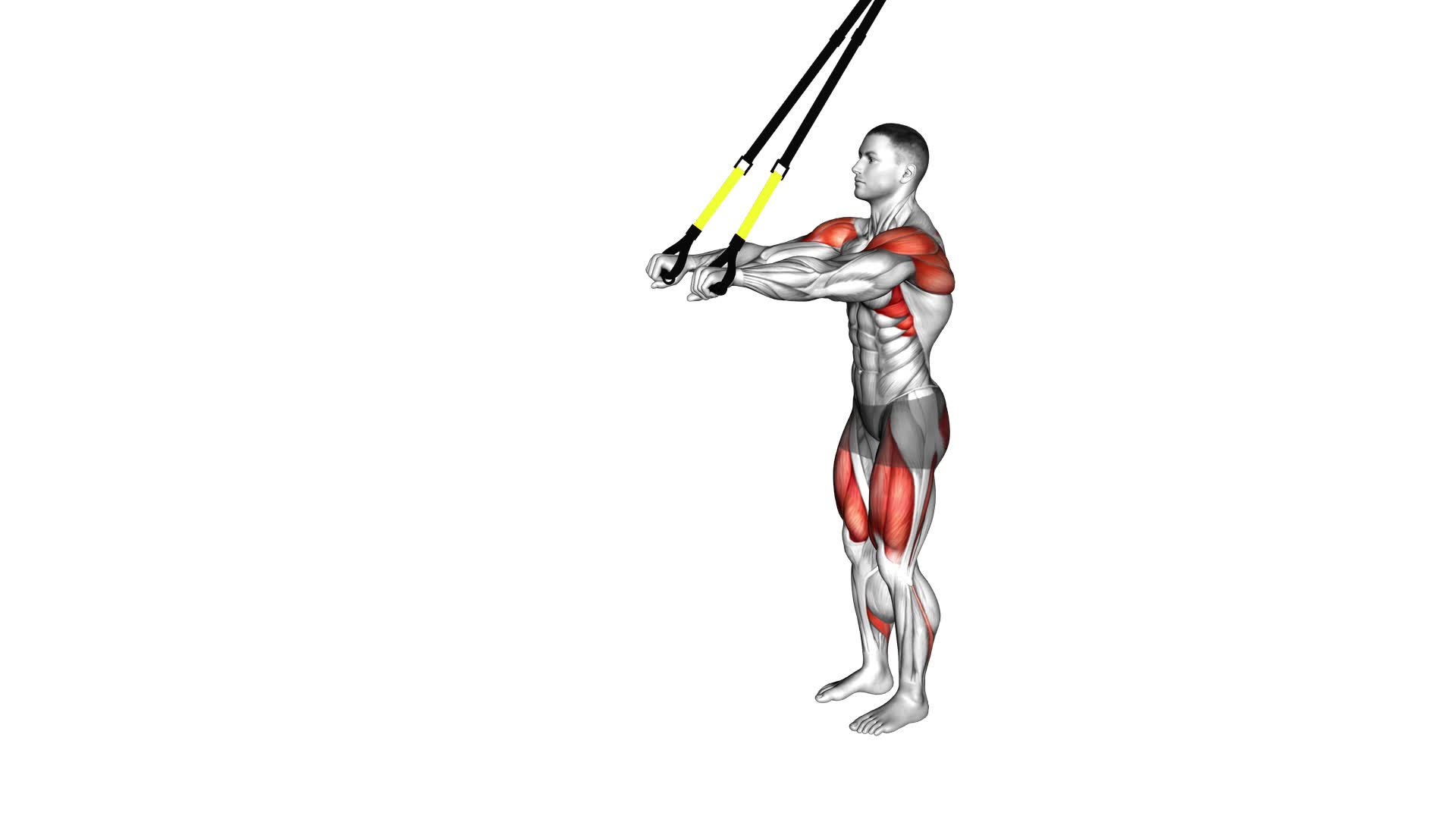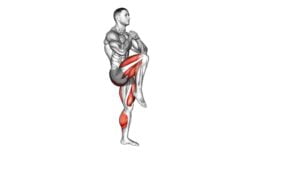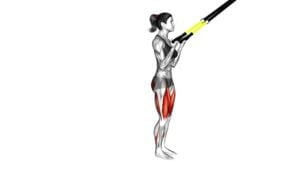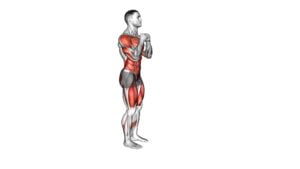Suspender Forward Lunge With Rear Fly (Male) – Video Exercise Guide & Tips

Get ready to amp up your workout routine with the Suspender Forward Lunge with Rear Fly. This exercise targets multiple muscle groups, providing you with a challenging and effective workout.
Watch This Exercise Video
In this video exercise guide, you'll learn the proper form and technique to maximize your results. Plus, we'll share some tips to help you avoid common mistakes and modify the exercise based on your fitness level.
Get ready to elevate your fitness game with this powerful move.
Key Takeaways
- Targets multiple muscle groups in the body, including quadriceps, hamstrings, glutes, upper back, shoulders, and arms
- Builds strength, endurance, and stability
- Improves overall lower body strength and posture
- Enhances balance and stability
Benefits of the Suspender Forward Lunge With Rear Fly
What are the benefits of performing the Suspender Forward Lunge With Rear Fly?
The Suspender Forward Lunge With Rear Fly is a compound exercise that targets multiple muscle groups in your body. It primarily works the muscles in your lower body, including the quadriceps, hamstrings, glutes, and calves. By incorporating the rear fly movement, it also engages the muscles in your upper back, shoulders, and arms.
This exercise is great for building strength, endurance, and stability. It helps to improve your overall lower body strength, making activities like walking, running, and jumping easier. Additionally, the rear fly component of this exercise helps to develop your upper back muscles, improving your posture and reducing the risk of back pain.
To incorporate the Suspender Forward Lunge With Rear Fly into your workout routine, you can perform it as part of a lower body or full-body workout. It can be done with dumbbells, resistance bands, or cable machines. Start with lighter weights and gradually increase as you get stronger and more comfortable with the movement.
In the subsequent section, we'll discuss the proper form and technique for the Suspender Forward Lunge With Rear Fly to ensure maximum effectiveness and minimize the risk of injury.
Proper Form and Technique for the Exercise
To perform the Suspender Forward Lunge With Rear Fly correctly, maintain proper form and technique throughout the exercise. Proper form is essential to ensure that you target the intended muscles and avoid injury.
Start by standing tall with your feet hip-width apart and your arms extended in front of you, holding the suspenders. Take a step forward with your right foot, bending both knees to lower your body into a lunge position. As you lunge, simultaneously extend your arms out to the sides, squeezing your shoulder blades together. Push off with your right foot to return to the starting position, and repeat on the other side.
Now, let's discuss common mistakes to avoid. One common mistake isn't maintaining proper alignment. Make sure that your front knee is directly over your ankle and doesn't go past your toes. Additionally, keep your back straight and avoid leaning forward or rounding your shoulders. Another mistake is using too much momentum. Control the movement and focus on engaging the muscles throughout the exercise.
If you're looking for exercise modifications, there are a few options. To make it easier, you can perform the exercise without weights or suspenders, focusing on perfecting your form and gradually increasing the difficulty. On the other hand, to make it more challenging, you can increase the weight of the suspenders or use dumbbells instead. Remember to choose modifications that suit your fitness level and goals.
Tips for Maximizing Your Results
To maximize your results, focus on proper form and technique during the Suspender Forward Lunge With Rear Fly exercise. This will ensure that you're targeting the right muscles and getting the most out of each repetition.
However, proper form and technique aren't the only factors that can contribute to your overall results. Here are some additional tips to help you maximize your gains:
- Nutrition tips for maximizing your results:
- Fuel your body with the right nutrients before and after your workouts. This can help optimize your performance and aid in muscle recovery.
- Consume enough protein to support muscle growth and repair. Aim for a balanced diet that includes lean sources of protein such as chicken, fish, tofu, and beans.
- Stay hydrated. Drinking enough water throughout the day can help maintain optimal performance and aid in recovery.
- Recovery strategies for maximizing your results:
- Incorporate rest days into your workout routine. Giving your body time to recover is crucial for muscle growth and preventing injuries.
- Get enough sleep. Aim for 7-9 hours of quality sleep each night to support muscle repair and overall recovery.
- Consider incorporating active recovery techniques such as foam rolling, stretching, or yoga to help alleviate muscle soreness and improve flexibility.
Common Mistakes to Avoid
Avoid these common mistakes to get the most out of the Suspender Forward Lunge With Rear Fly exercise. When performing this exercise, it's important to be aware of the mistakes that can hinder your progress and increase the risk of injury.
One common mistake to avoid is using too much weight. It can be tempting to go heavy and push yourself, but using excessive weight can compromise your form and increase the risk of strain or injury. Start with a weight that allows you to maintain proper technique throughout the exercise.
Another mistake to watch out for is rushing through the movement. The Suspender Forward Lunge With Rear Fly exercise requires controlled and deliberate movements. Take your time and focus on maintaining proper form and alignment. This will ensure that you're engaging the correct muscles and maximizing the benefits of the exercise.
Lastly, don't forget to engage your core. Many people neglect to activate their core muscles during this exercise, which can lead to poor balance and stability. Keep your core tight throughout the movement to maintain proper posture and stability.
Modifications and Progressions for Different Fitness Levels
As you progress in your fitness journey, there are various modifications and progressions you can incorporate into the Suspender Forward Lunge With Rear Fly exercise to challenge yourself and continue improving your strength and stability. Here are some adaptations and advanced variations to consider:
- Increased resistance: Once you have mastered the basic form of the exercise, you can add more weight to the suspender handles or use heavier dumbbells during the rear fly movement. This will further engage your muscles and enhance the difficulty of the exercise.
- Plyometric lunges: To increase the intensity and add a cardiovascular element to the exercise, you can incorporate plyometric lunges. Instead of stepping forward into the lunge, explosively jump off the ground and switch legs mid-air, landing in a lunge position. This will help improve your power and agility.
- Single-leg suspender lunges: For an additional challenge to your balance and stability, you can perform the exercise using only one leg at a time. Step forward into a lunge position with one leg while keeping the other leg off the ground. This variation will target your leg muscles even more and require greater core strength.
Remember to always listen to your body and progress at a pace that feels comfortable yet challenging. By incorporating these adaptations and advanced variations into your routine, you can continue to push yourself and achieve new levels of fitness.
Frequently Asked Questions
How Many Sets and Repetitions Should I Do for the Suspender Forward Lunge With Rear Fly Exercise?
To determine the number of sets and repetitions for the suspender forward lunge with rear fly exercise, consider your fitness level and goals. Start with 2-3 sets of 10-12 repetitions per leg.
As you progress, increase the intensity by adding more sets or reps. Remember, form is crucial, so focus on proper technique throughout.
If you don't have suspenders, you can use dumbbells or resistance bands as alternative equipment for this exercise.
Can I Do This Exercise With Dumbbells Instead of Using Suspenders?
Yes, you can modify the Suspender Forward Lunge With Rear Fly exercise by using dumbbells instead of suspenders. This alternative equipment allows you to perform the same movement pattern and engage the same muscle groups.
By holding the dumbbells in your hands, you can still lunge forward and perform the rear fly motion.
This modification provides a convenient option if you don't have access to suspenders or prefer using dumbbells for your workout.
Should I Perform This Exercise Before or After My Cardio Workout?
To maximize the benefits of performing the suspender forward lunge with rear fly exercise, it's important to consider when to do it in relation to your cardio workout. Generally, it's recommended to perform strength exercises like this one after your cardio session. This way, your muscles are warmed up and ready for the challenge.
However, make sure not to rush through the exercise and focus on proper form to avoid common mistakes and prevent injury.
Is It Normal to Feel Some Discomfort in My Lower Back During the Suspender Forward Lunge With Rear Fly?
Feeling some discomfort in your lower back during the suspender forward lunge with rear fly isn't uncommon.
To prevent lower back pain, make sure you maintain proper form and engage your core muscles throughout the exercise.
Additionally, you can modify the exercise by using lighter weights or performing the movement without weights altogether.
Remember to listen to your body and stop if the discomfort persists or worsens.
Can I Incorporate This Exercise Into a Full-Body Workout Routine?
Yes, you can definitely incorporate the Suspender Forward Lunge with Rear Fly into your full-body workout routine.
This exercise targets multiple muscle groups, including your legs, glutes, back, and shoulders, making it a great addition to a comprehensive workout plan.
By performing this exercise, you can improve your strength, stability, and overall body coordination.
It's a versatile exercise that can provide numerous benefits when incorporated into your routine.
Conclusion
Incorporating the suspender forward lunge with rear fly into your workout routine can offer numerous benefits. This exercise helps improve lower body strength, upper body posture, and stability. To maximize your results, it is important to ensure proper form and technique. This means maintaining a straight back, engaging your core, and keeping your knees aligned with your toes during the lunge. Additionally, avoiding common mistakes, such as allowing your front knee to extend past your toes, can help prevent injury and ensure an effective workout. It is also important to make modifications based on your fitness level. If you are a beginner, you may want to start with lighter weights or no weights at all, and gradually increase the intensity as you become more comfortable and stronger. Lastly, consistency is key. By incorporating this exercise into your regular routine and following these tips, you can enjoy the positive impact it will have on your overall fitness.

Author
Years ago, the spark of my life’s passion ignited in my mind the moment I stepped into the local gym for the first time. The inaugural bead of perspiration, the initial endeavor, the very first surge of endorphins, and a sense of pride that washed over me post-workout marked the beginning of my deep-seated interest in strength sports, fitness, and sports nutrition. This very curiosity blossomed rapidly into a profound fascination, propelling me to earn a Master’s degree in Physical Education from the Academy of Physical Education in Krakow, followed by a Sports Manager diploma from the Jagiellonian University. My journey of growth led me to gain more specialized qualifications, such as being a certified personal trainer with a focus on sports dietetics, a lifeguard, and an instructor for wellness and corrective gymnastics. Theoretical knowledge paired seamlessly with practical experience, reinforcing my belief that the transformation of individuals under my guidance was also a reflection of my personal growth. This belief holds true even today. Each day, I strive to push the boundaries and explore new realms. These realms gently elevate me to greater heights. The unique combination of passion for my field and the continuous quest for growth fuels my drive to break new ground.







